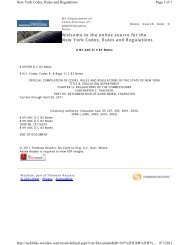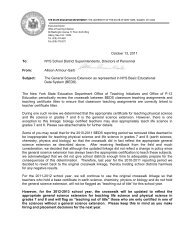ESL Learning Standards - Higher Ed - New York State Education ...
ESL Learning Standards - Higher Ed - New York State Education ...
ESL Learning Standards - Higher Ed - New York State Education ...
You also want an ePaper? Increase the reach of your titles
YUMPU automatically turns print PDFs into web optimized ePapers that Google loves.
Students will demonstrate cross-cultural knowledge and sensitivity in communicating with others of<br />
varied social, cultural, and linguistic backgrounds. They will develop and use culturally appropriate<br />
behaviors, and a knowledge of local and U.S. cultures and practices, in their interactions with<br />
others in their new cultural environment.<br />
<strong>ESL</strong><br />
5<br />
Intermediate (5 – 8) Commencement (9 – 12)<br />
1. Demonstrate an understanding of cultural and language<br />
patterns and norms in American English, including different<br />
regional and social varieties of English.<br />
Such patterns and norms include levels of formality,<br />
slang, humor, idioms, rhetorical patterns, and standard<br />
vs. nonstandard dialects.<br />
(L, S, R, W)<br />
2. Demonstrate an understanding of a broad range of U.S.<br />
cultural and political referents through institutions, functions,<br />
and processes at the local and national levels,<br />
and compare/contrast these with parallels in the students’<br />
native community.<br />
Such cultural and political referents include holidays,<br />
symbols, traditions, customs, governance systems, and<br />
schooling.<br />
(L, S, R, W)<br />
1. Demonstrate an understanding of cultural and language<br />
patterns and norms in American English, including different<br />
regional and social varieties of English, and identify<br />
and interpret how these patterns and norms are<br />
used.<br />
Such patterns and norms include levels of formality,<br />
slang, humor, idioms, rhetorical patterns, and standard<br />
vs. nonstandard dialects<br />
(L, S, R, W)<br />
2. Demonstrate an understanding of a broad range of U.S.<br />
cultural and political referents through institutions, functions,<br />
and processes at the local and national levels,<br />
and compare/contrast these with parallels in the students’<br />
native community.<br />
Such cultural and political referents include holidays,<br />
symbols, traditions, customs, governance systems, and<br />
schooling.<br />
(L, S, R, W)<br />
PERFORMANCE<br />
INDICATORS<br />
3. Recognize and share cross-cultural experiences and<br />
idea, and connect with those of others.<br />
(L, S, R, W)<br />
4. Interpret and demonstrate knowledge of nonverbal and<br />
oral communication features, and understand the contexts<br />
in which they are used appropriately.<br />
Such means of nonverbal communication include gestures,<br />
body language, volume, stress, intonation, and<br />
pace.<br />
(L, S)<br />
5. Compare and contrast oral traditions, myths, folktales,<br />
and literature from the United <strong>State</strong>s and international<br />
regions and cultures, including the students’ own, and<br />
identify similarities and differences and universal<br />
cultural themes.<br />
(L, S, R, W)<br />
6. Recognize and demonstrate an appreciation of some<br />
commonalities and distinctions across cultures and<br />
groups (differentiated by gender, ability, generations,<br />
etc.), including the students’ own.<br />
(L, S, R, W)<br />
3. Recognize and share cross-cultural experiences and<br />
idea, and connect with those of others.<br />
(L, S, R, W)<br />
4. Interpret and demonstrate knowledge of nonverbal and<br />
oral communication features, and understand the contexts<br />
in which they are used appropriately.<br />
Such means of nonverbal communication include gestures,<br />
body language, volume, stress, intonation, pace,<br />
rhythm, and pauses.<br />
(L, S)<br />
5. Compare and contrast oral traditions, myths, folktales,<br />
and literature from different national and international<br />
regions and cultures, including the students’ own, identifying<br />
similarities and differences and universal cultural<br />
themes, and exploring how language and literature<br />
transmit culture.<br />
(L, S, R, W)<br />
6. Recognize and demonstrate an appreciation of some<br />
commonalities and distinctions across cultures and<br />
groups (differentiated by gender, ability, generations,<br />
etc.), including the students’ own.<br />
(L, S, R, W)<br />
Performance Indicators<br />
by Grade Level 29
















